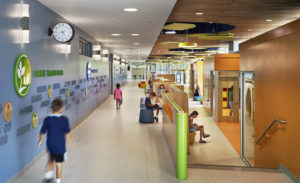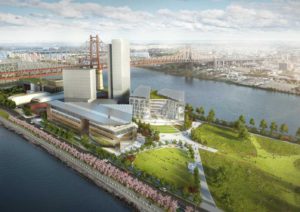State Policies & Programs School & District Leadership Research & Tools
This section highlights state policies and national programs working toward zero energy schools; districts pursuing zero energy and the strategies they use to achieve this target; feasibility studies, assessment strategies, and other technical looks at zero energy school design; and case studies of successful zero energy school buildings.
Schools represent the ideal building type to lead the market shift toward zero energy buildings. Currently, schools make up the third largest subsector of commercial building energy usage. Many schools face growing populations, aging buildings, constrained operating budgets, and increasing energy bills. The cost of energy is one of few budget items schools can reduce without negatively affecting student learning. A zero energy school presents the opportunity for environmental, economic, and educational benefits including improved indoor air quality, higher attendance rates and teacher retention, valuable educational opportunities, lower maintenance costs, and more stable budgets.
SCHOOL & DISTRICT LEADERSHIP
SFUSD Carbon Reduction Plan
SFUSD is embarking on a multi-decade effort to achieve carbon neutrality by 2040. The technology exists to construct buildings that use no more energy than they generate, and all new SFUSD buildings will be built to this standard. SFUSD’s goal is to achieve a 50% reduction in natural gas usage by 2030 and to stop burning it entirely by 2040. This document was developed with input from Facilities, Buildings & Grounds, the Bond Department, and numerous other stakeholders from the City of San Francisco and elsewhere. It spells out the District’s board-adopted goal to be carbon neutral by 2040 and the manner in which that goal shall be achieved.
SFUSD Project Requirements
Motivated by the California State Architect’s 7x7x7: Design Energy Water Challenge, SFUSD has completely transformed the process by which it designs, constructs, and modernizes its buildings in order to achieve a carbon neutral district by 2040. New buildings must be Zero Net Energy (ZNE) ready, modernized buildings are modeled so a pathway to ZNE can be incorporated into the design phase, and all facilities and deferred maintenance projects must adhere to a strict set of requirements to ensure alignment with ZNE goals. This document outlines the district’s requirements for windows, insulation, building controls, boiler replacement, plumbing fixtures, and rainwater catchment in building projects.
SFUSD Carbon-Neutral Schools Resolution: In late September, the Board of Education took action to ensure the future of San Francisco Unified School District would be sustainable by passing the Carbon-Neutral Schools Resolution. The resolution makes SFUSD the first in the nation to adopt fossil fuel reduction targets in an effort to curb impacts from global climate change. Among other strategies, the district’s Carbon Reduction Plan includes a zero net energy (ZNE) requirement for new buildings which strives to cut natural gas use in school buildings by half by 2030 and eliminate it altogether by 2040.
Hermosa Beach City School District ZNE Charrette
With support from Southern California Edison (SCE), New Buildings Institute (NBI) hosted a charrette and lead participants through a serious of discussions and brainstorming activities to begin defining Hermosa Beach City School District’s Roadmap to zero net energy (ZNE). Participants included the district superintendent, board members, a school principal, engineers, architects, sustainability consultants, city representatives, construction management team members, SCE, Savings By Design program representatives, and a Hermosa Beach student. The goals for the day were to gain a greater understanding of ZNE and ZNE practices and how they relate to the district’s long and short term goals, to develop stakeholder messaging around ZNE, and to work together to meet the school board’s goal of high performance sustainability while achieving cost effectiveness.
Discovery Elementary Zero Energy School
 Discovery Elementary was designed to be a zero energy building, meaning that the amount of energy produced annually by on-site renewable energy sources is equal to the amount of energy used annually. Discovery is currently the largest zero energy school in the United States. As a carbon neutral producer of clean energy, the school offers a positive example of a solution to a global crisis – and along the way emboldens students with the expectation that they are creative participants in those solutions.
Discovery Elementary was designed to be a zero energy building, meaning that the amount of energy produced annually by on-site renewable energy sources is equal to the amount of energy used annually. Discovery is currently the largest zero energy school in the United States. As a carbon neutral producer of clean energy, the school offers a positive example of a solution to a global crisis – and along the way emboldens students with the expectation that they are creative participants in those solutions.
Greening Boulder Valley School District
Boulder Valley School District has accomplished much in the past three years to reduce energy consumption, and energy use has decreased significantly, saving the district thousands of dollars. The district met its five-year energy goal a year ahead of schedule. In 2013, the Energy Team completed a new Sustainable Energy Plan. This plan sets new five-six year targets, with the long term goal of zero energy capable buildings by 2050. The plan also provides detail on the methodology for achieving the new goals and specific strategies, including estimates on initial costs and ongoing savings.
San Diego Unified School District Energy Management Plan
This Energy Management Plan was designed to support Vision 2020, Quality Schools in Every Neighborhood, through sustainability initiatives, leveraging internal and external funding to provide high quality and energy efficient educational environments, supporting student achievement, while decreasing general fund expenditures and setting the vision towards zero energy for San Diego Unified schools.
Fayette County Sustainability Program: E=USE2 Program
This flagship initiative for students, E=USE2 (Education leads to Understanding Sustainability, Energy and the Environment), is a six-step program that guides hands-on investigations of energy data, energy awareness campaigns, and school improvement projects. Fayette County Public Schools has also adopted green building practices in all our construction and renovation projects to ensure that our schools are environmentally friendly. In addition, FCPS is an Energy Star partner committed to reducing consumption.
Adams 5-Star K-12 Schools
The Energy & Sustainability team is responsible for managing utility use and for promoting Social, Economic and Environmental Sustainability for the district. Between 2009 and 2016, the team has implemented conservation measures that have reduced energy costs by $1.1 million annually. The team has begun work on a strategy to eventually achieve a district goal of of zero waste and zero energy. The schools and district departments are taking steps to ‘go green’, working to be wise stewards of resources.
Cornell University 2013 Climate Action Plan Update & Roadmap 2014-2015
 The Climate Action Plan (CAP) is Cornell’s overarching plan to move to a low carbon future. The original CAP was developed in 2009 by Cornell faculty, students, and staff with funding from the state energy authority, NYSERDA. The plan was intended to enhance the university’s core mission of education, research, and outreach, while cutting net carbon emissions to zero by 2050. Since 2008, Cornell has initiated a total of 62 actions to green its campus and has reduced gross emissions by nearly 32%, and by nearly 50% since 1990. These collective actions are significant steps forward and have established Cornell as a national leader among universities that have committed to climate neutrality.
The Climate Action Plan (CAP) is Cornell’s overarching plan to move to a low carbon future. The original CAP was developed in 2009 by Cornell faculty, students, and staff with funding from the state energy authority, NYSERDA. The plan was intended to enhance the university’s core mission of education, research, and outreach, while cutting net carbon emissions to zero by 2050. Since 2008, Cornell has initiated a total of 62 actions to green its campus and has reduced gross emissions by nearly 32%, and by nearly 50% since 1990. These collective actions are significant steps forward and have established Cornell as a national leader among universities that have committed to climate neutrality.
